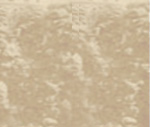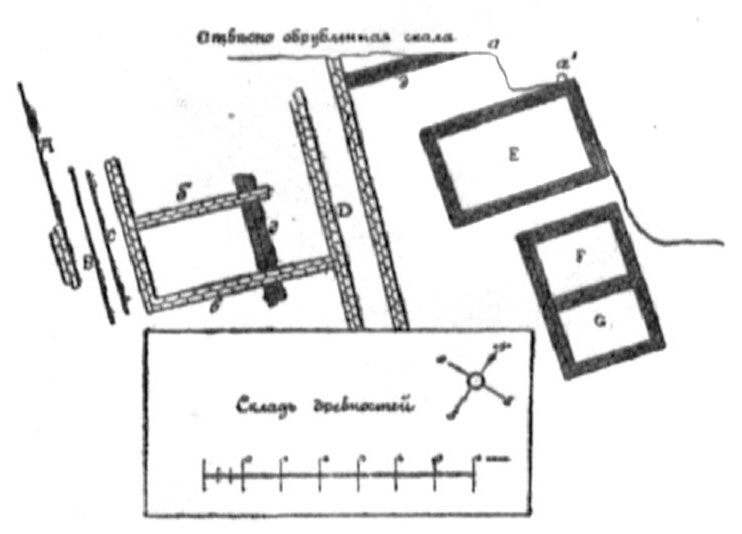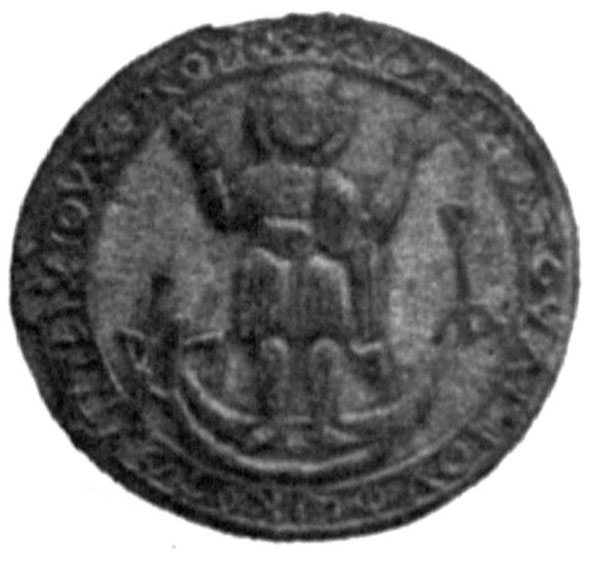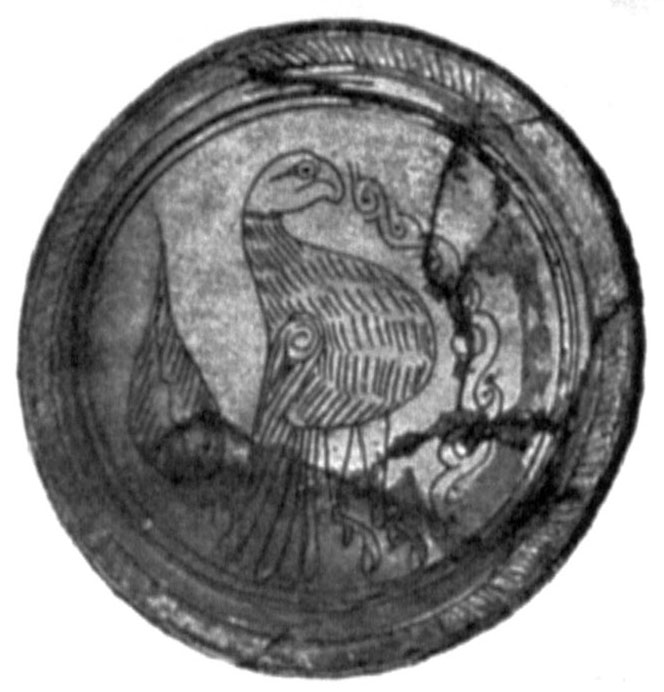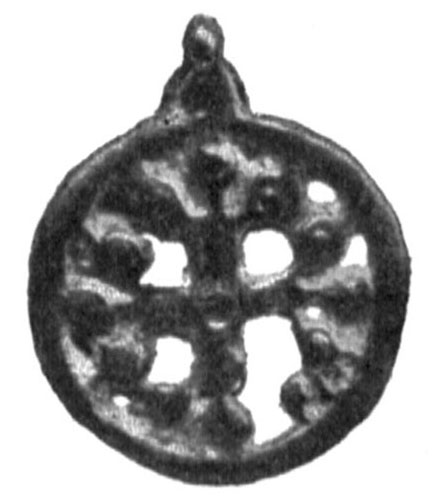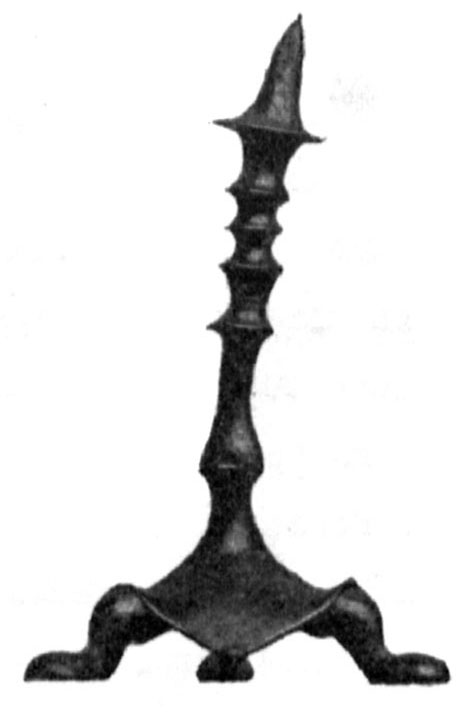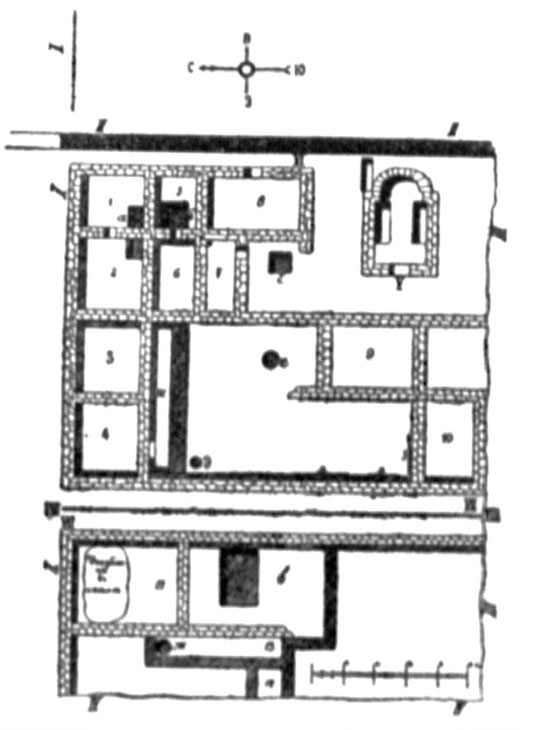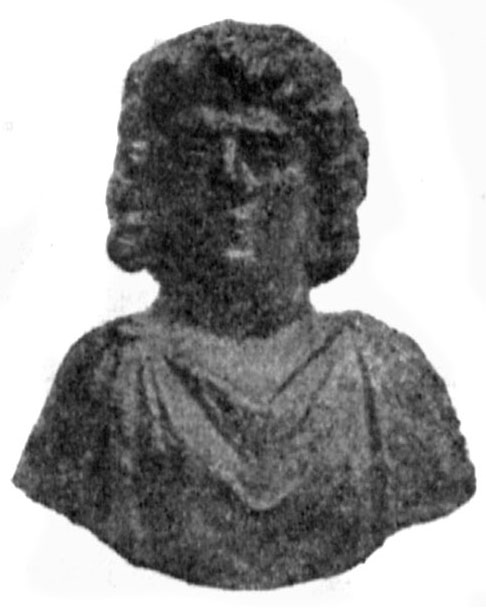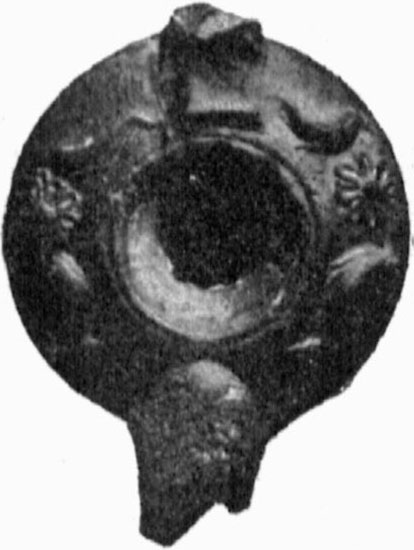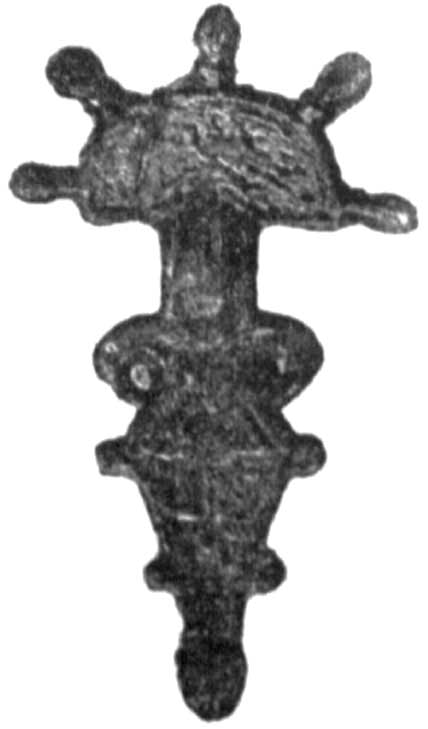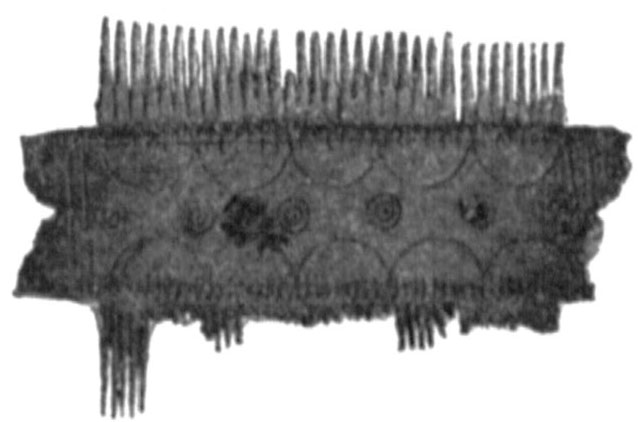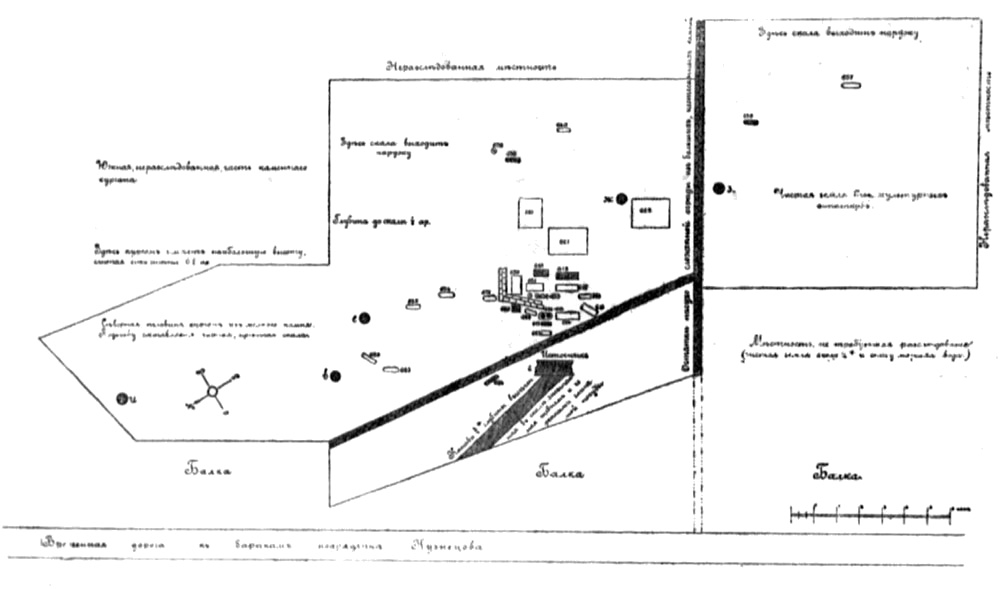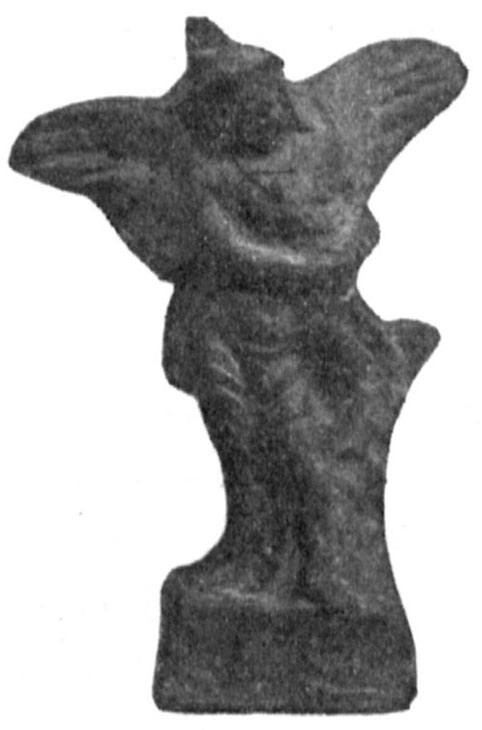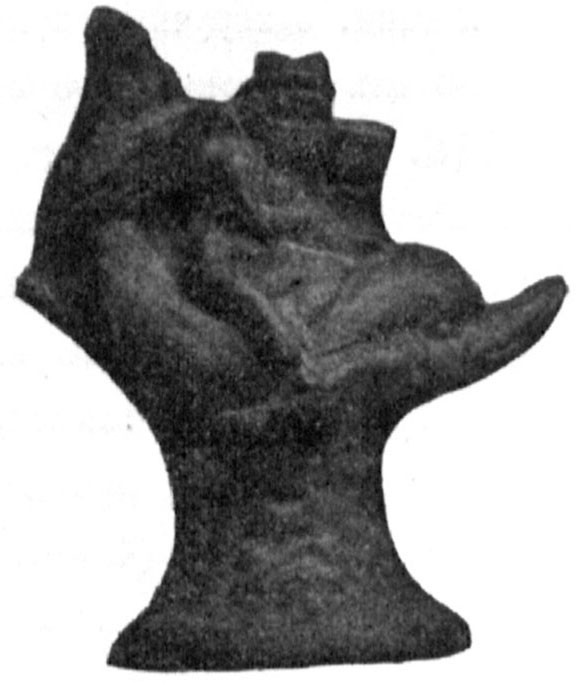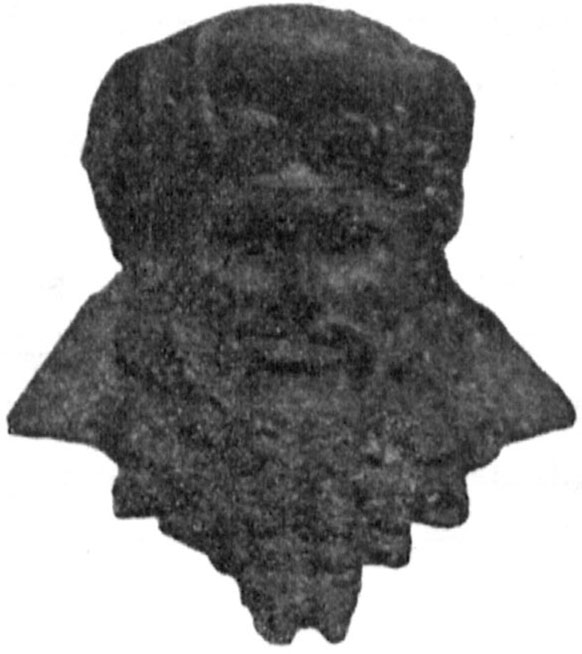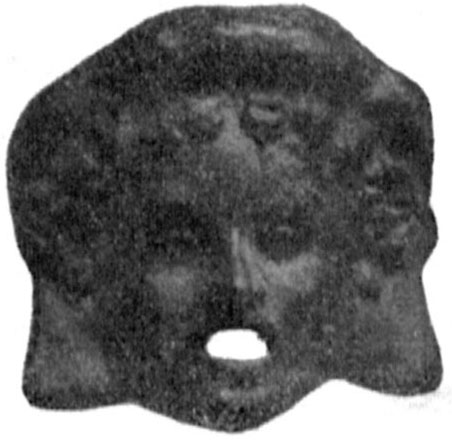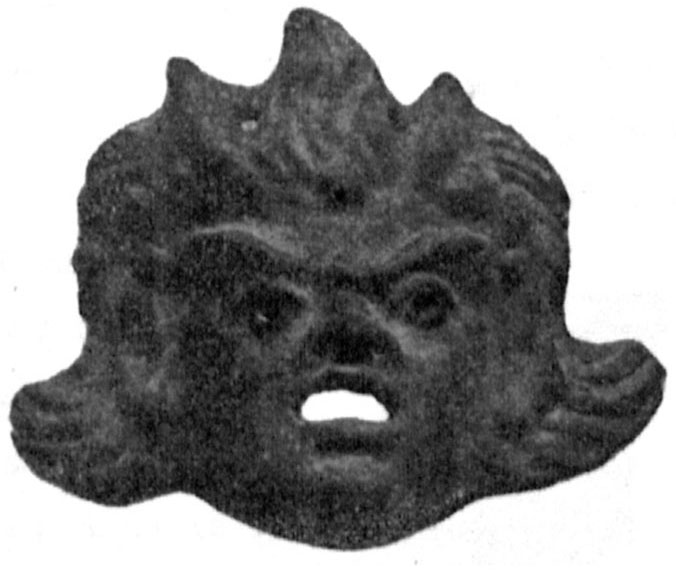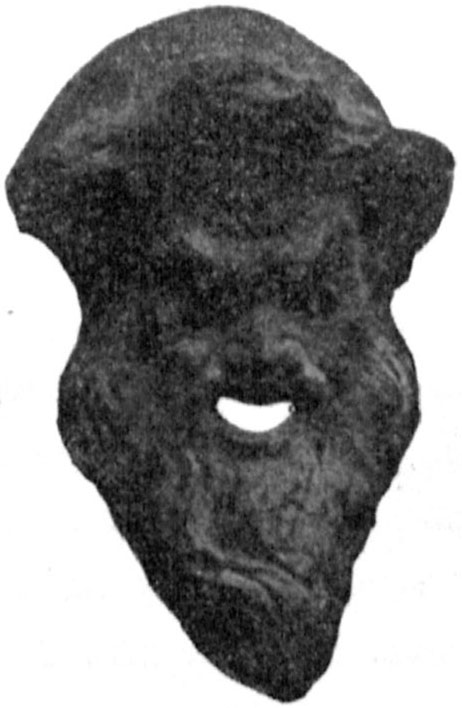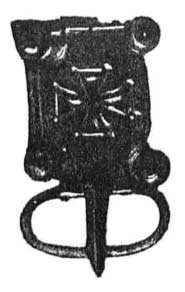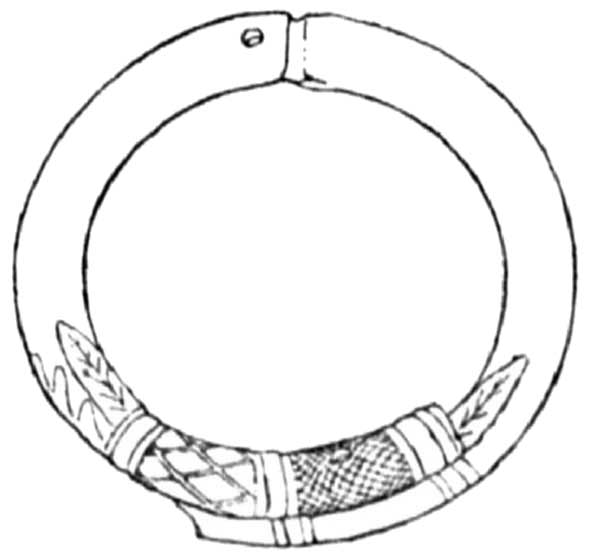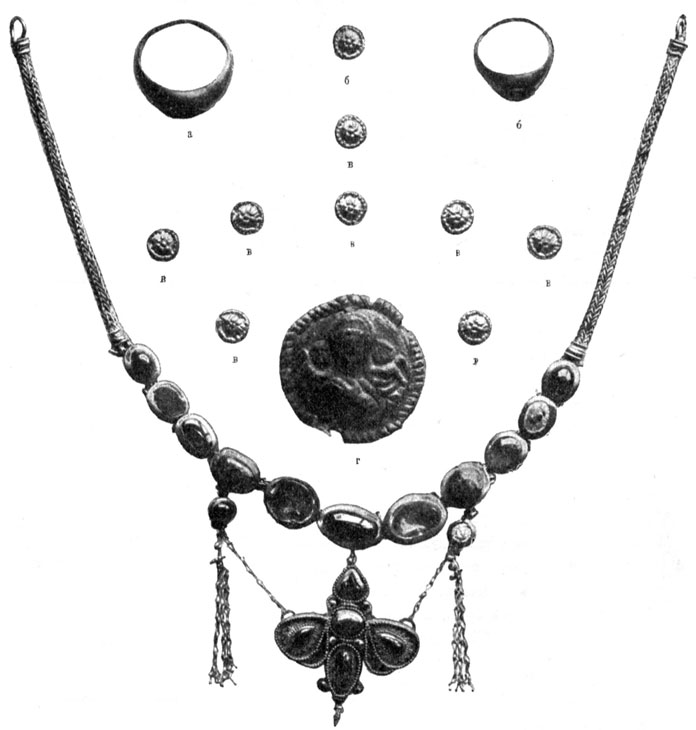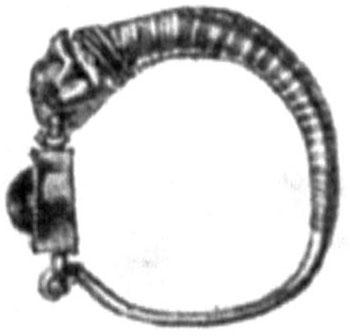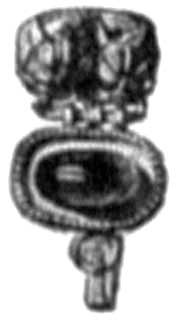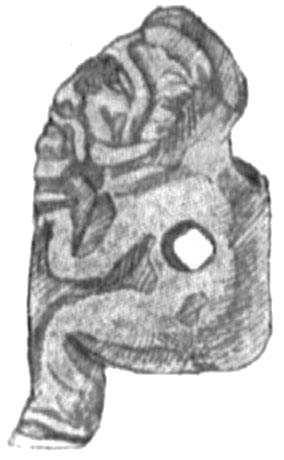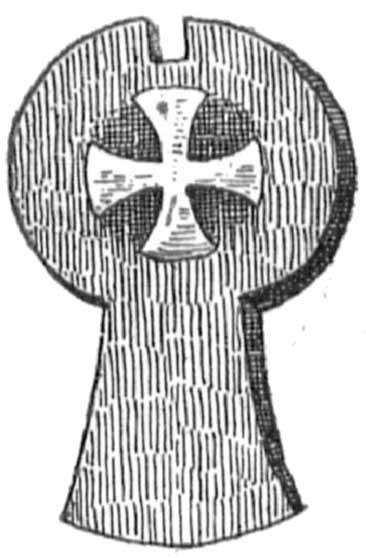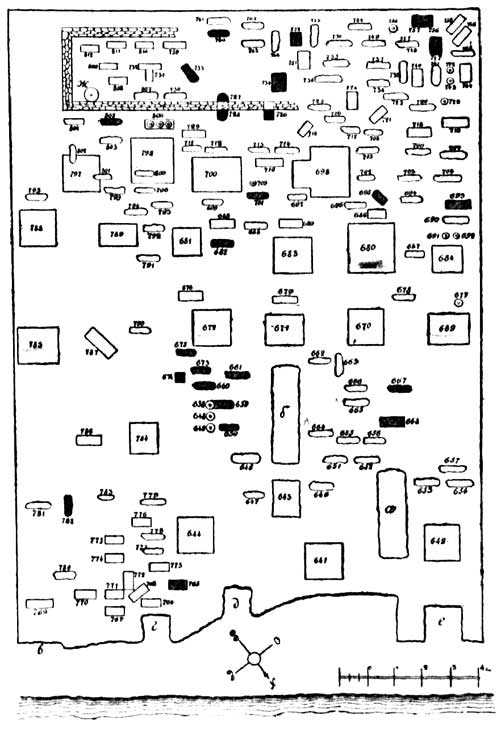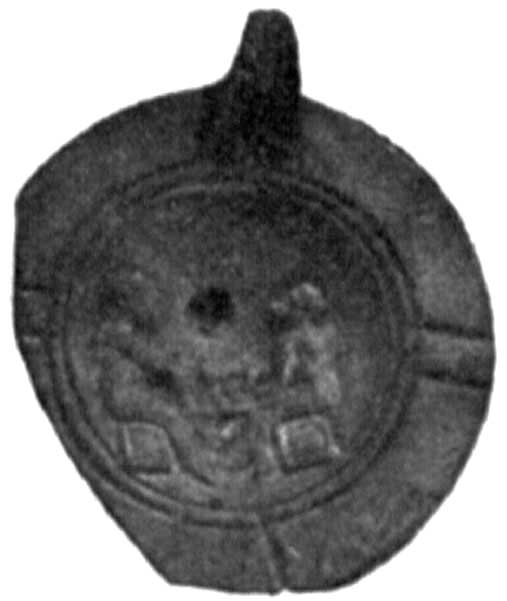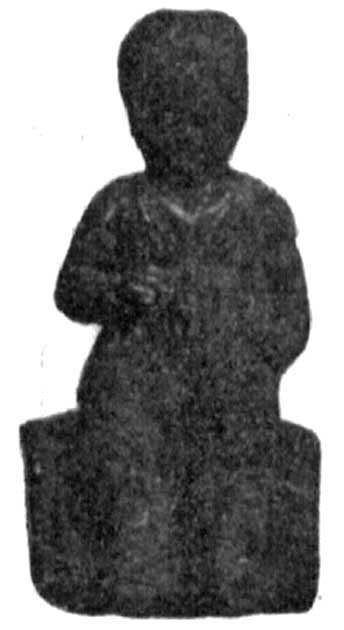1896 REPORT OF THE HEAD OF THE EXCAVATIONS IN CHERSONESOS K. K. KOSTSYUSHKO-VALYUZHINICH (PART 1)
The Excavations of the site of ancient Chersonesos to the north from the warehouse of antiquities
In the year under report, the excavations in this place continued to the n<orth> from the warehouse of antiquities as long as the vertically cut cliff that is 4 ½
archines
high at a
(s<ee> the plan at fig. 530 [1]).
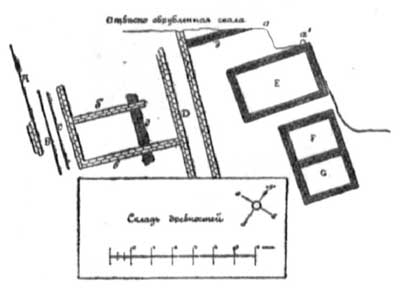
|
| Fig. 530 |
Apart from the street (A) with remains of two stone drainage canals (B and C) located one above another but in different vertical planes, there is a lane (Д) discovered 14 arch<ines> far to the east from the street; it is 2 archines wide and is the closest to the sea; this lane comes to the
altarless church
discovered in 1892. In between of the street and the lane, there are vestiges of 2 transverse walls (let<ters> б and в) from the upper and one longitudinal wall (let<ter> г) from the lower, more
ancient city
[2].
In the east<ern> section of this area, the excavations unearthed an insignificant sector of some ancient wall (let<ter> д) of unknown purpose and three perfectly
preserved cisterns
(let<ters> Е, F and G), 4 to 5 arch<ines> deep, with cemented walls and brick floors. The southernmost cistern (let<ter> G) was filled to the brim with oyster shells; at the footing of this cistern, sil<ver> coin of autonomous Chersonesos (it is probably unpublished; on the one side is Artemis's head to the right, with quiver behind the back, on the other the beast running right and hardly visible traces of an inscription below) was discovered.
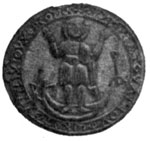
|
| Fig. 531 |
Two other cisterns were filled with stone and soil. The big northern cistern contained top right corner of Doric capital of local sandstone with the final words of two-line Greek inscription
[3]
and, in top layers, flat clay circle of irregular form, 3 ½" - 4" in diameter, with double raised border, within which are relief cross and single-line Greek inscription. In the circle, there is image of St. Phocas standing in a boat with his hands raised; the head is nimbate; a fish is hanged to the belt on the left; there is fishgig under the bow of the boat and steering oar and two oars at the stern
(fig. 531)
. As it can be seen on the break of the back side, this circle was fixed on a rod.
Stone matrix in the shape of slate tablet for casting crosses and rings was uncovered hereabouts; and at the wall of the lane, in top layer of soil, there were 44 bron<ze> coins of the first Byzantine emperors laying in the same place. Besides that, there were: mar<ble> cornice fragment with a part of single-line Greek inscription; 2 fragments of mar<ble> slabs that also had remains of Gr<eek> inscriptions; earthen<ware> plug in original form (2 ½" in diameter, with letter N above); bron<ze> quadrangular weight (also with letter N on top); bron<ze> bowl (3" in diameter), heavily destroyed by oxidizing,
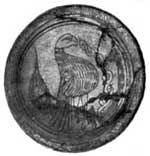
|
| Fig. 532 |
with single-line Oriental inscription around; various glazed earthenware vessels; bowl, damaged by fire, 8 ¾'' in diameter, of light yellow color, with impressed image of sitting hawk
(fig. 532)
; 2 bottoms of bowls with roughly-drawn image of bird and checkered design of white, green and brick red color; earthen<ware> tureen, 6 ¾" in diameter, heavily damaged by fire, and 120 multicolored earthen<ware> shards; 20 stems of glass goblets (3 of them had survived fragments that allow one to imagine the form of these Byzantine period goblets); fragment of marble mortar; stone mortar in the form of truncated pyramid upside down; fragment of black slip earthen<ware> lamp; 2 earthen<ware> lamps (one black with high stem and another plain red slip one); iron ploughshare and axe, both damaged; quernstone for hand mill; 2 bone handles for knives (one is decorated with circles, another is plain); straight bron<ze> key and 3 fragments of the same keys; 3 bron<ze> arrow-heads; ir<on> spear tip; 3 thr<owing> stones; fragment of ir<on> stirrup; ir<on> horse chains, for two legs, with lock; 2 plain bron<ze> quadrangular weights; 6 bron<ze> fishhooks; earthen<ware> sinkers for fishing nets (30 in the form of truncated pyramids and 2 cylindrical); 40 ring-shaped lead sinkers, which were discovered in the same place; b<one> piercers; 1 bone and 4 earthen<ware> spindle whorls; 2 earthen<ware> balls; 2 g<old> pendants, the first one is lunar, with loop
(fig. 533)
,
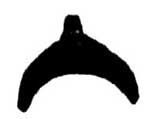
|
| Fig. 533 |
the second in the form of double wire ring; 3 g<old> beads; sil<ver> finger-ring with round blue glass; bron<ze> finger-ring with the so-called "Solomon's Seal" carved from above, alike roof tiles and Golden Horde coins discovered in Chersonesos
[4]; 3 plain bron<ze> finger-rings, of rough workmanship; bron<ze> hair pin and bron<ze> spoon for cleaning ears; 5 bron<ze> belt buttons in the form of flies and rosettes; 3 bron<ze> belt buckles; 2 pendants in the form of bron<ze> swords; multitude of fragments of glass bracelets; 2 fragments of gl<ass> rings; 9 r<ound> and oval glasses for finger-rings; coral fly-shaped pendant (the loop that was on its top is missing); 2 carnel<ian> beads; one coral and 3 multic<olored> beads; bottom part of bron<ze> cross with rough image of the Savior; 2 bron<ze> crosses, one of which, in circle, was carved from the same plate with the latter
(fig. 534)
;
2 fragments of bron<ze> icon lamp chains; earthen<ware> thurible lid; 6 bron<ze> buttons in the form of closed bells; bent bron<ze> candlestick 8 ½" high that consisted of 2 parts: base with 3 feet and rough pointed rod for pinning candles
(fig. 535)
;
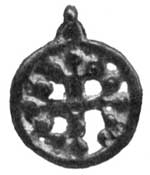
|
| Fig. 534 |
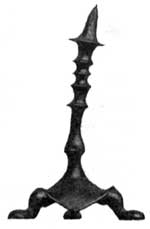
|
| Fig. 535 |
bron<ze> button in the form of hexapetalous rosette, with an eyelet within its concave side; cross within circle (4 ½ in diameter), carved in relief into fragment of limestone slab; 6 multicolored fragments of thin mar<ble> slabs (3 of dark green color with light green spots, 1 of red color with pink spots, one white with black spots, and one white with pink streaks); 2 pieces of red wall-plaster; roof tiles from the Byz<antine> period; 18 wild boar's tusks; goat's horn; fragment of horn carved through, in the form of cut basin, with circular hole below, at the thin tip; b<one> tube, 1 ¾'' long and 3/8" - 5/8" in diameter, with two holes at the thin tip located opposite to each other; bron<ze> coins of Chersonesos dated to pre-Chrisian period - 3 pieces
[5],
to Christian period - 115 pieces [3]; from the last kings of Bosporos - 4 pieces; of the later Roman and Byzantine emperors - 82 pieces; oriental - 13 pieces; destroyed by oxidizing - 5 pieces. In total, 267 coins were uncovered.
The excavations in the south-eastern extremity of the square, in front of the church
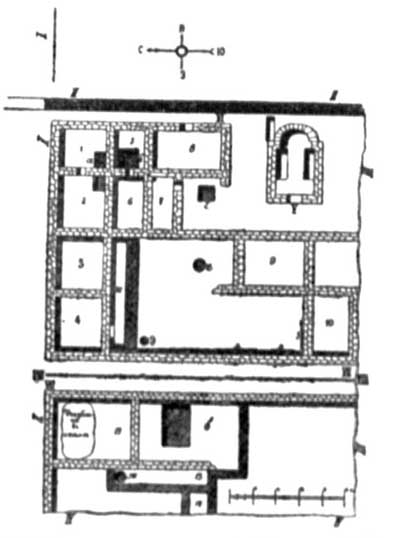
|
| Fig. 536 |
The part of the monastery square in front of the
new church, investigated in this year as deep as the bedrock
(s<ee> the plan at fig. 536)
, ), was limited by: on the n<orth>, by the only wide street (I) going through the whole eastern extremity of the ancient city site; on the e<ast>, by the new monastery wall (II), that was constructed in 1891; on the s<outh>, by high mound of soil, fine stone and rubble (III) that developed in the form of a slope when laying out the square and building the church from 1861 to 1892 and formed thick layer covering wide uninvestigated strip in the central part of the ancient city; and, finally, from the w<est>, by the remains of basilica separated from the excavation by young trees planted in 1895 (IV). The excavations were made as deep trench without separating layers, the ground and fine stones from the buildings in the upper Byzantine city were taken away and dropped from the said escarp, and the investigations of the ancient substructure site, which was especially interesting in this area of the city site, was made without driving the soil away, but with leveling the ground and removing bigger stones.
The discoveries made when unearthing the upper city: altarless church with 3 tombs (V); 2 streets (VI and VII), the last of which had drainage canal (VIII) of stone slabs; 11 living rooms from the upper city
[7];
4 cemented cisterns (let<ters> a, б, в and г); 3 wells for rainwater (let<ters> д, е, and ж); vestiges of pavement, aqueduct of pottery pipes (let<ter> з), and lower city walls that consisted of big ashlars of hard rock, laid without lime.
The dimensions of the alterless church are as follows: length 8 arch<ines> and 10
versh<oks>
, width 4 arch<ines> and 8 versh<oks>, apse diameter 3 arch<ines> and 10 versh<oks>. The mensa laid in the chancel of the altarless church; it is made of
Inkerman
stone (15 х 15 х 3), with square slot (11 х 11 х ½) and beveled sides, and was fixed on tetrahedral stone pedestal (5 ½ х 5 ½), the height of which could not be determined as only a part of this pedestal survived. The letter ran through stone slab (1 arch<ine> and 2 versh<oks> х 1 arch<ine> and 2 versh<oks> х 3 ¼ versh<oks>) laying on the brick floor in the chancel. The floor in the altarless church was of stone slabs. Inside, there were 2 tombs, either 3 arch<ines> and 4 versh<oks> long, 1 arch<ine> and 4 versh<oks> wide, and 1 arch<ine> and 6 vershoks deep. The north one has no top slabs, though only one of the slabs that had covered the south tomb remained. The walls of the tombs were plastered. Human bones laid in disorder, mixed with soil and fine. The north tomb contained: 2 gl<ass> child's bracelets; gl<ass> child's ring; 2 bron<ze> child's earrings; 2 bron<ze> buttons in the form of small closed bells and bronze coin cast for Chersonesos by the emperor Romanus I. On the outside of the altarless church, to the left from its apse, there was one more tomb 3 arch<ines> long, 14 versh<oks> wide, and 14 versh<oks> deep. This tomb appeared to contain nothing but the bones, similarly to the southern one. At the entrance to the altarless church, there were 7 fragments of fine bronze icon: Resurrection, with inscription ANACTACHC above and impressed images of the Savior standing, who holds cross in one hand and takes kneeling aged man off coffin, with young man wearing armor and with shield standing behind the latter. The icon is heavily damaged by oxidizing and its right side is missing. In one of the rooms near the altarless church (no. 7), there was charred skeleton of adult man laying on the floor, with earthenware, heavily damaged by fire, gl<azed> juglet near it. There is a street 4 arch<ines> wide, that is most close to the new church and goes with right angle from the main street downhill, to the bay; it was paved with stone slabs, and drainage canal ran below it.

|
| Fig. 537 |
When making further investigation below the Byzantine city level, down to the bedrock, that is 3 archines deep in between of the altarless church and the escarp, we discovered remains of ancient constructions laid of big slabs, dressed from either side and closely fit without lime mortar. In the corridor (let<ter> и) located in front of rooms nos. 3 and 4 (its walls are laid of perfect slabs), there was bron<ze> half-size image of woman en face
(fig. 537)
, with smooth back surface and rod 3/8" long. In room no. 3 there was big iron anchor with two flukes and hole for stock.
The wall masonry type in rooms nos. 1-4 и 11 and shards of fine black slip pottery of high quality discovered there prove that these buildings are of ancient origin; if one takes into account that, as can be seen from the plan, all of them form the south side of the main street (I) discussed above, one can be confident that the Byzantine city inherited this wide and beautiful street from the ancient Greek Chersonesos, and that the street went through the acropolis. There must be the best temples and monuments; some of the latter have been discovered by the excavations being lost around; among them, the stele with civic oath, psephism honoring Diophantos and Aristonos, as well as pedestals for the Athena sculptured by Polycrates, and for Diones, the priest of Parthenos (literally 'Virgin'). 3 circular wells (let<ters> д, е, ж) for storing rainwater and 4 cisterns (let<ters> а, б, в, г) for storing grain, salted fish and other consumer goods date to the same period
[8].
The finds from the well ж are: neck of Rhodes amphora with both its handles stamped; 3 amphora handles with stamps of the same colony; amphora handle from Sinope, with the name of astynomos, and handle from unknown colony with the name of, obviously, the potter; 130 shards of excellent fine black slip pottery. The well е contained, apart from multitude of simple earthen<ware> pottery shards, big straight bron<ze> key, and, above, bron<ze> finger-ring with unclear ornamentation carved into the plate.

|
| Fig. 538 |
The following antiquities were found when investigating this part of the ancient city site down to the bedrock: top right corner of marble stele with Greek inscription, of which only 5 letters in two lines survived; 2 fragments of mar<ble> slabs with vestiges of Gr<eek> inscriptions; 3 amphora handles with names of astynomoi of Chersonesos; 2 stamped handles of amphorae from Phasos; amphora handle with letter N within circle; ancient Gr<eek> roof tile fragment with image of bunch of grapes and name of astynomos of unknown colony; bron<ze> weight in the shape of flat circle with letters I В; 22 bron<ze> coins of Cherson<esos> dated to the pre-Christian period
[9],
bron<ze> coins of Christ<ian> period
[10],
in total there were 254 bron<ze> coins of Chersonesos from pre-Christian and Christian periods; 17 l<ead> lead votive symbols from Chersonesos
[11]:
12 bron<ze> coins of Bosporan kings dated to the most late period; 220 bron<ze> coins of the late Roman and Byzantine emperors; 40 bron<ze> unreadable coins destroyed by oxidizing; l<ead> seal with damaged Byzantine inscription on one side and monogram on the other; l<ead> seal, also with damaged Byzantine inscription on one side, and standing figure of a saint on the other; fragment of lead seal with few letters of Byzant<ine> inscription; lower part of earthen<ware> mold for statuette of a woman; lower part of mar<ble> statue of medium size consisting of pedestal, laying woman (the head is broken off), naked legs of human figure standing above her, goat's hoofs to the right, and bottom part of broken-off quadrangular beam that survived behind the latter
[12];
bronze herma, 1 ½" high, with rod behind, at the foot; fragment of carelessly made terracotta image of Demeter; fragment of terracotta statuette of shaggy silen; 24 fragments of black slip earthen<ware> pottery with traces of ornamentation; 110 similar shards but without decorations; 2 tureen bottoms with initials
 and
and
 ;
;

|
| Fig. 539 |
scratched on them; fragment of earthen<ware> vessel consisting of short wide neck with hole below (3/4" in diameter), fastened to saucer that was connected by handle to the top part of the neck; high earthenware vessel with narrow neck and no handles; 160 glazed earthenware pottery shards; glass bottle neck, plain on top and covered with cord like a spiral below; 13 gl<ass> foot for vessels similar to wineglasses; half of big mar<ble> mortar; 3 fragments of mar<ble> mortars; fragment of flat mar<ble> cup; cubic stone mortar; black slip earthen<ware> lamp, damaged, in excellent condition; earthen<ware> lamp with relief artistic images of bearded head of satyr, two rosettes and four dolphins
(fig. 538)
; fragment of earthen<ware> lamp with relief image of woman's face to the left, with high coiffure and necklace of beads; 6 b<ig> earthen<ware> lamps without images; 2 minor earthen<ware> lamps, also without images, of extremely rough manufacture; 3 stone millstones (one is 15 ¼ in diameter, with egg-shaped reach-through hole in the middle, and five fingers carved around it at the depth of 1"); 3 whetstones (one without hole, another with hole for hanging to the belt, third with cut corners and one-side bevel edges, with riveted bronze detail and ring)
(fig. 539)
, for hanging to belt [13];

|
| Fig. 540 |
2 bron<ze> keys, one straight, another with herma-shaped bust; 2 fragments of bron<ze> keys; b<one> handle for knife, decorated with double circles; 2 b<one> plates, with one side decorated with pattern of lines and circles with dots, that were used for handle of clasp knife
(fig. 540)
; bron<ze> stick
with spade, that possibly was coroplast's tool; bron<ze> detail; bron<ze> screw ½" long, with hollow head broken into two fragments; 5 bron<ze> arrowheads; 12 small throwing stones; 3 bron<ze> weights (2 in the shape of flat circle and 1 small in the form of truncated cone); 69 earthen<ware> sinkers in the form of truncated pyramid, one with roughly-carved image of face en face, others without images; 30 cylindrical earthen<ware> sinkers; 2 ring-shaped l<ead> sinkers; 2 b<one> piercers; broken b<one> piercer, decorated with human head, of rough workmanship;

|
| Fig. 541 |
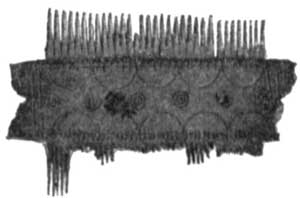
|
| Fig. 542 |
b<one> tube with hole from one side, probably for spinning threads; 2 bron<ze> needles and 1 b<one> needle, 6 earthen<ware> and 11 l<ead> spindle whorls; 5 earthen<ware> balls; 2 b<one> checkers (one is decorated with circles, another with cross-form cuts); gl<ass> circle, with one side convex, which possibly was checker as well; pierced shell; big twisted g<old> earring, decorated with rosette; smaller twisted gold wire earring; g<old> bead; 3 g<old> semicircular badges (one with stamped human face and a hook, another is small, rosette-shaped, openwork and with eyelet, the third with double circle and 4 holes); g<old> nail, ½" long, with flat head; bron<ze> finger-ring with oval convex glass gem; round bron<ze> mirror, heavily damaged; 2 bron<ze> belt buckles; bron<ze> brooch, of the so-called Gothic type, similar to the one represented at baron de Baye's, La bijouterie des Goths, Paris, 1892, p. 112
(fig. 541)
;
bron<ze> dagger-shaped pendant; fragment of bone comb, decorated with circles and carving
(fig. 542)
; 10 glasses of different size, round and oval, from finger-rings and brooches; 368 fragments of gl<ass> bracelets; 2 b<one> plaques, decorated with circles, for caskets; cross of sheet copper, ¾" х 5/8", with rounded tips and 4 mounting holes
[14];
fragment of flat bron<ze> chain for icon lamp, in openwork, with crosses and small orb on top; 2 fragments of icon lamp chains; 7 bron<ze> buttons in the form of small closed bells; fragment of bron<ze> spoon; 2 fragments of columns, one of pinkish marble, another of yellowish sandstone, fluted; 2 bases of marble and 2 of local limestone;

|
| Fig. 543 |
2 fragment of marble Doric cornice (one with egg-and-dart); stone quadrangular pedestal, with pierced-through hole; truncated sandstone pyramid with pierced-through hole in the middle and 4 symmetrically located crosses carved into its surface; 8 fragments of red wall plaster; 6 fragments of window panes; 2 roof tiles of the Byzant<ine> period; 18 ceramic water pipes, 3 ½" in diameter and 1' 7" long; 5 bron<ze> nails with semicircular heads; pointed top part of marble ancient Greek gravestone similar to the one described in 1891 Otchёt Arkh<eologicheskoy> Kom<issii> (Archaeological Commission Report), p. 18, fig. 11
[15];
8 wild boar's tusks; fragment of deer's horn, 4 pieces of the same horns, sawn; horn's end, pointed like hexahedral pyramid with hole on top; feldspar cornice-shaped plate 2" х ¾" х ¼" (on the one end there are two holes pierced by an awl); artifact of unknown purpose, in the form of two bron<ze> spoons, 1" long each, hinged together; in the middle of the depression in one spoon, there is rod ¼" long, and on the convex side of both spoon there is carved image of human face, of rough workmanship
(fig. 543).
Uncovering the basilica that was discovered in 1861
This year, we started investigation of the chancel of the basilica discovered in 1861 down to the bedrock; this basilica is adjacent to the excavations described above (in the 2nd chapter); in result, 756 pieces of smalt were unearthed, namely: 472 with gilding, 110 black, 108 blue, 36 red, and 30 green. As it was considered before, only the so-called Uvarov basilica had chancel decorated with wall mosaics. S<ee> A. L. Berthier-Delagarde's study Raskopki Khersonesa (Excavations of Chersonesos) in 12th volume of Mater<ialy> po arkheologii Rossii (Materials for the archaeology of Russia), publ<ished> by the Imperial Archaeological Commission, p. 47
[16].
Excavations in the necropolis of Chersonesos
The only place for accumulation of soil and fine stone mined when excavating vast south slope of the city site of Chersonesos is the ravine lying near the road from Sevastopol to the monastery. In order to check the hypothesis that once this ravine was a branch of Karantinnaya bay, so funeral structures should not appear along the whole length of it, reconnaissances have been made in various parts of the ravine starting from the road facing the gate made in the ancient wall;
these reconnaissances consisted of digging nine trenches and discovered that the soil did not contain any cultural layer but the sea water was very close and appeared as deep as 2 - 2 ½ arch<ines>.
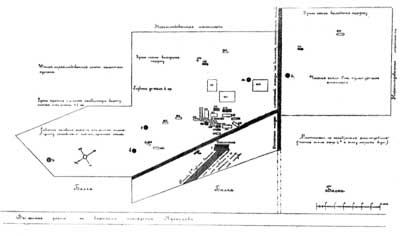
|
| Fig. 544 |
Another indicator of the bay that undoubtedly existed there is the find of, within a relatively small excavated area, five wells
(fig. 554, let<ters> в, е, ж, з, и)
, carved into bedrock, 2 to 5 arch<ines> d<eep>, and a source of water collected into stone pool (let<ter> г), now collapsed, that was 2 arch<ines> d<eep>. The excess of the water goes from the pool to the ravine via ditch 3 arch<ines> w<ide> and ¾ arch<ines> d<eep>, that is carved into bedrock and filled with rubble and simple earthen<ware> pottery shards. The wells and the pool are located in the beginning of the slope, at the south side of the ravine; similarly to the wells that now exist in the source of Karantinnaya, Yuzhnaya, and Balaklavskaya bays, they are made with the purpose of catching the water arteries by which the water from the mountainous part of the peninsula is streaming to the sea, with the minimum investment of labor.
In the n<orthern> part of the ravine, atop large slanting area, there is a sector of the necropolis that was called 'south' in the reports and had been being investigated in past five years to the most possible extent. This year excavations started from insignificant slope going from the south side of the ravine, which was crossed, in several places, by ancient walls laid of big stones without mortar
(s<ee> the plan at fig. 544
[17])
. The eastern border of the excavations is cairn of irregular shape, 6 ¾ arch<ines> high. The northern half of this cairn that is close to the road and consists of fine stone, similar to the cairn in Shverin's acres, was removed in the year under report, and the stone distributed through the valley by wheelbarrows. Similarly to Shverin's cairn, under the given cairn there was plain strong bedrock without any trace of funeral constructions; in one corner only was circular well, carved into bedrock, where saltish water appeared as deep as 2 archines. Similarly to Shverin's cairn, this one was not strengthened with big slabs at the base. It is possible to explain its construction as the Chersonesites's desire to free the large ravine from stones; in the same time, the ravine was drained by a specially made mound, where the defensive wall erected in the Roman period. There could be vegetable gardens like the ones located now in the nearest ravine between the road from Sevastopol and Karantinnaya bay source. When removing the stones, the following artifacts were uncovered from the cairn: fragment of Doric cornice of local sandstone with beautiful ornamentation; fragment of round column of the same material; fragment of big marble statue (piece of a shoulder); millstone; throwing stone, and 3 bron<ze> coins (of Caucasian Caesarea, one of the most late Bosporan kings, and late Roman one).
To the north from the cairn, bedrock gradually rises and comes out 15
sazh<enes>
far from the road towards the former monastery hotel. There were the following tombs uncovered by the excavations
[18]:

|
| Fig. 544 |
- This tomb (1 ¾ arch<ines> l<ong>, 8 versh<oks> w<ide>, and 8 versh<oks> d<eep>) is carved into bedrock and contained skeleton of child. No slabs appeared to be above it, which is why the tomb was filled with soil. It contained: g<old> earring in the form of lattice with heart-shaped blue glass insert; g<old> crescent pendant with wide eyelet
(fig. 545)
; elongated g<old> bead; pair of twisted silv<er> child's bracelets; bone pendant in the form of hand showing fig sign; herma-shaped b<one> pendant; 12 beads of paste with multicolored strips and eyes; 2 glass beads; nacreous bead (the first such artifact found); lead in shapeless form; 10 knucklebones; 2 artistic terracotta statuettes of Eros embracing a rooster and Eros with cithara sitting on dolphin's back
(figs. 546 and 547)
, terracotta masks of young Bacchus, Bacchae, Pan, and Satyr
(figs. 548,549,550,551)
. This was the first time when several terracotta figures were uncovered in tomb within the necropolis of Chersonesos.
 |
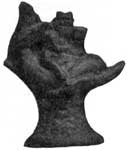 |
 |
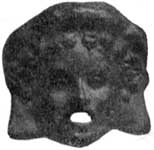 |
 |
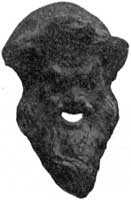 |
| Fig. 546 |
Fig. 547 |
Fig. 548 |
Fig. 549 |
Fig. 550 |
Fig. 551 |
- and 613. Two earthen<ware> urns, each with three handles, crushed. These were located close to tomb no. 611, in the room that was carved into bedrock. Amidst cremated bones, there were silv<er> plain finger-ring and two cuff links in the form of thick silver wire, that was bent twice, and had pyramidal decorations put on its ends (similarly to gold cuff links as pictured in Drevn<osti> Bosf<ora> Kim<meriyskogo> [The Antiquities of Cimmerian Bosporos], Plate XXXII, 14, and 1867 Otch<ёt> Arkheolog<icheskoy> Kom<issii> [Archaeological Commission Report], Plate II, 32).
- The tomb (3 arch<ines> l<ong>, 1 arch<ine> wide, and 1 ½ arch<ine> d<eep>) was carved into bedrock. It contained: milky color gl<ass> bottle (crushed); 3 single-handled earthen<ware> juglets; earthen<ware> saucer with high foot; 5 plain earthen<ware> lamps of the same size and form; 3 bron<ze> coins of Chersonesos (s<ee> Burachkov's Sbornik [Collection], pl<ate> XVI, nos. 91, 117 and 104, but above Artemis there are visible letters
CO).
- tomb, 2 arch<ines> and 14 versh<oks> l<ong>, 1 arch<ine> and 1 versh<ok> w<ide>, and 1 arch<ine> deep, with the wall plaster excellently preserved; no slabs appeared on top. Removed soil contained glazed earthen<ware> saucer with high foot.
- Similar tomb with child's burial, 1 arch<ine> and 9 versh<oks> l<ong>, 9 versh<oks> d<eep>, and 8 versh<oks> w<ide>, uncovered; there was shell with hole (not local) found in the removed soil.
- Similar tomb, 2 ½ arch<ines> х 1 arch<ine> х 1 arch<ine>, without top slabs. The finds: single-handled earthen<ware> juglet; earthen<ware> lamp with relief image of rosette, and 19 beads (10 of multicolored glass, 8 of paste, and 1 of amber).
- Similar tomb, 2 ¾ arch<ines> х 1 arch<ine> and 2 versh<oks> х 1 arch<ine>; it contained plain black slip earthen<ware> lamp.
- This tomb is laid of big ancient Greek tiles, only one of which uncovered intact, with stamp of bad preservation. The tomb appeared to have no top slabs and was filled with soil; the finds made when removing the soil were black slip earthen<ware> plate (crushed) and 8 lead bunches in the form of trefoils with hook on top.
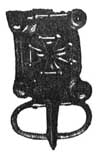
|
| Fig. 552 |
- This catacomb (4 arch<ines> l<ong>, 2 arch<ines> and 5 versh<oks> w<ide>, and 1 arch<ine> and 10 versh<oks> h<igh>) had 3 bed-shaped niches (1 ¼ arch<ine> w<ide> and 1 arch<ine> and 6 versh<oks> h<igh>). The passageway to the catacomb (13 versh<oks> х 12 versh<oks>) was oriented to the n<orth> and closely covered with a slab. One skeleton laid on each bed, and the right from the entrance one appeared to have two footwear soles (9 ¼" long and 2 ½" wide as maximum; one а very good preservation) and gold threads perhaps from tassels. The middle skeleton was accompanied with blue glass bottle. On the floor, there were three more skeletons with the legs oriented to the exit; the one from the right had the skull deformed to a great extent. In between of the latter skeleton and the next one, there was big broken buckle of low-grade silver (3" х 2"), of the so-called Gothic type, with the image of cross pressed into its surface
(fig. 552)
. This buckle indicates Christian burial. Although one can not prove that this buckle was possessed by the extreme skeleton with deformed skull, the joint burial of this member of a mysterious ethnos with Christian Greeks already makes a discovery of no small importance
[19].

|
| Fig. 553 |
- This catacomb is located near the previous one but with the exit to the e<ast>; it is 4 ¾ arch<ines> l<ong>, 3 arch<ines> and 10 versh<oks> w<ide>, and 2 arch<ines> and 9 versh<oks> h<igh>, with 2 bed-shaped niches. On the floor, there were boards of one child's and thee big coffins. The boards of the first one preserved well and were transported to the warehouse of antiquities. In the catacomb, there was only one bron<ze> coin of the emperor Arcadius (395-408).
- The catacomb (5 arch<ines> l<ong>, 5 arch<ines> w<ide>, and 2 ¾ arch<ines> high) has passageway leading to the n<orth> and 3 niches of usual form. The bones were scattered on the floor. The soil removed from the tomb contained g<old> earring in the form of ring with one side thickened and the other side cut through
(fig. 553).
- Stone basin-shaped coffin (1 ¼ arch<ine> l<ong> and ¾ arch<ine> w<ide>) was broken into pieces and covered by slab. It contained skeleton of child accompanied with 2 gl<ass> bottles, b<one> box with lead (2 ½" high), 1 chalcedonic and 1 carnelian bead, and bron<ze> coin of Chersonesos (Burachkov, <Op. cit.>, pl<ate> XVI, 115).
- Underground tomb. Single skeleton appeared to be accompanied by broken black slip double-handled grooved vase decorated with wreath.
- Underg<round> tomb with burial of a child. It contained: b<one> handle for small bell; pierced shell (not local); red slip earthen<ware> plate; 16 beads of multicolored glass.
- This tomb is carved into bedrock for child's burial; it is 1 ¼ arch<ine> l<ong> and 12 versh<oks> w<ide> and d<eep>. As it was not covered with slab, its grave goods, namely red slip earthen<ware> vessel, with single handle, in the form of laying ram, gl<ass> saucer, chiseled b<one> box, and medallion made of thin silver plate, with stamped image of human head, appeared to be crushed. The other finds are: sil<ver> pendant in the form of two miniature pails with handles soldered together (s<ee> 1895 Otch<ёt> Arkheol<ogicheskoy> Kom<issii> [Archaeological Commission Report], p. 113, fig. 284); pair of child's earrings of g<old> wire; scarab-shaped pendant of yellow paste; 5 amphora-shaped pendants (2 of amethyst, 2 of carnelian, 1 of rock crystal); pyramid-shaped pendant of rock crystal; 50 beads (1 of rock crystal, globular, with longitudinal grooves, 3 plain of rock crystal, 14 plain round of carnelian, 4 plain round of chalcedony, 1 big, elongated, of multicolored paste, 20 of multicolored paste, of different forms, 6 flat of jet, and 1 amber, also flat).
- Underground tomb that contained narrow g<old> leaf with hooks along its edges, from a wreath; child's bron<ze> bracelet; 16 round beads of multicolored paste, and 8 elongated beads of blue glass.
- Similar tomb, that contained single-handled earthen<ware> juglet and ir<on> knife blade.
- This tomb is laid of big ancient Gr<eek> roof tiles that appeared to be crushed by the wall; the latter is 12 versh<oks> wide, it was probably constructed in the Roman period, as there is tomb of stone slabs (no. 630) annexed to the wall on the other side of it. Near the tomb, there were broken black slip tureen and 3 l<ead> three-leaved bunches with hooks above that were taken away probably in course of building of the wall.

|
| Fig. 554 |
- This is tomb constructed of stone slabs (2 arch<ines> and 14 versh<oks> l<ong>, 15 versh<oks> w<ide>, and 14 versh<oks> d<eep>), closely blocked with slabs fit to each other, and oriented from n<orth>-e<ast> to s<outh>-w<est>; it adjoins the wall that goes above the ancient Gr<eek> tile tomb (no. 629) and appeared to be untouched. It contained woman's skeleton with the head oriented to s<outh>-w<est>, in extended position, with the hands on chest. Stone footing of the tombs was covered with inconsiderable layer of deposited soil and fine shells; no traces of boards and nails for coffin have been unearthed. Lower than the legs, at the edge of the tomb, there were bright glass bottle (damaged) and stick of the same glass, 8 ¾" long, with flat circles on either end (fragments of such sticks have been found in tombs several times). On the legs, there were silv<er> ornamented hoops in the form of two tubes, 3/8" in diameter, bent like a semicircles. One side of one tube is fixed in the other tube with solid rod, so the tubes can be opened and closed, and the other side of this tube enters into the other and is fastened through the hole to prevent the hoop from falling down from the leg
(fig. 554)
. Silver is oxidized and has become fragile. A bit higher, on the right, there was big circular bron<ze> mirror, completely destroyed by oxidizing. Beads were scattered through the whole tomb, beginning from the legs; small jet beads fell to smallest pieces (among the collected beads there were 98 of glass, 19 of multicolored paste, 2 of amber, and 1 big flat of jet decorated with circles). At the right hand, there were two g<old> hollow finger-rings; one of them, with oval amethyst with carved warrior's head, was probably put on forefinger, due to its size
(fig. 555a)
,and the other, small one with plain oval convex garnet
(fig. 555б)
, was on the little finger. From there and to the head, on both sides of the skeleton, there were scattered 17 round g<old> sewing badges with stamped image of six-pointed stars
(fig. 555в)
and 64 components of two g<old> bracelets, of two types, each of the same number, and namely: in the form of seven ribbed tubes of different size soldered together, and seven short ribbed tubes of the same size
(fig. 556)
.
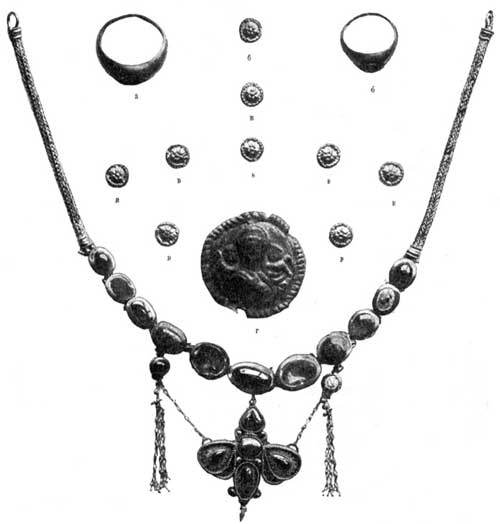
|
| Fig. 555 |

|
| Fig. 556 |
Similar beads have been found in tombs before, but these tombs were plundered and the number of the finds was small, because of which these tubes were considered components of necklaces. At the head, there were: pair of big gold earrings in the form of double cord with big wire hook on thin end and thick and decorated with two lynx's head hinged to oval medallion with plain convex garnet and eyelet for passing hook through
(figs. 557a side view and 557б front view)
;
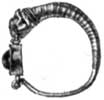 |
 |
| Fig. 557a |
Fig. 557б |
); gold necklace of excellent preservation
(fig. 555)
, that consisted of two chains in the form of woven cord (each 3" long), with loops on top, and of eleven gold plain oval medallions, hinged together and hanged to the said chains; the closer to the medium, the biggest one, the bigger is the medallion. In the medallions, there are 9 stones and 2 glasses in oval form (the glasses and 2 stones are flat, the rest 7 stones are convex). The order of the stones and circles from left from the viewer is the following: garnet; glass; dark amethyst (it may by sapphire); emerald; topaz; garnet (central medallion); topaz; emerald; amethyst; glass; almandine (or garnet). There is fastened to the central medallion gold pendant in the form of big butterfly (1 ½" l<ong> and 1 3/8" w<ide>), decorated with granulation, 4 garnets (3 are egg-shaped and one is heart-shaped) and emerald in the centre. The fourth from the end medallions have hinged small g<old> medallions with inserted convex garnet in the left one and flat glass in the right one. These small medallions have hanged tassels of three thin gold chains ending with nine balls. Either of these two medallions is connected with butterfly's wing by the same g<old> chain. The chains consist of links entering each other. As symmetry is observed in every detail, it is possible to consider that both small medallions had garnets, one of which was lost and replaced with glass
[20].
Other finds from this place: 11 rock crystal pierced beads (9 round, of different size, and 2 big oval flat); 2 thin circular silv<er> badges with stamped image of Aphrodite and two Erotes
[21]
(fig. 555г)
;
sil<ver> head pin (broken), with top decoration of a handle holding ball with three fingers
[22]
; earthen<ware> handleless vessel; earthen<ware> single-handled cup, and 2 pieces of pink pigment (rouge). There were absolutely no earthen<ware> lamps, glass narrow-neck balsamaria, and bron<ze>coins that were so popular in the tombs of Chersonesos. This tomb was moved to the square in front of the warehouse of antiquities and installed near the big tomb no. 599 that was uncovered in 1895
[23].
- This tomb (12 versh<oks> far to the w<est> from the previous one) is constructed of stone slabs also (2 arch<ines> l<ong> and 14 versh<oks> w<ide>) and is totally plundered. Apart from shards of earthen<ware> pottery and crushed gl<ass> bottles, there were rumpled g<old> badge in the form of pointed cap and earthen<ware> lamp with relief image of cock.
- Crushed earthen<ware> urn with twisted handle. Apart from cremated bones, it contained 3 pieces of thin sheet gold and silv<er> child's expandable bracelet.
- This double-handled urn was crushed. Apart from cremated bones, it contained g<old> wire earring.
- Underground tomb. The single skeleton of woman was accompanied by bron<ze> coin of Chersonesos (Burachkov, <Op. cit.>, pl<ate> XVI, 103); 2 sil<ver> finger-rings, one of which is decorated with carnelian gem with carved image of warrior stepping right; small bron<ze> shoe buckle; 8 beads of green paste, ribbed, circular; 44 beads of multicolored glass and one flat amber bead; small round bron<ze> mirror destroyed by oxidizing.
- Similar tomb with child's burial. It contained bron<ze> bracelet with bron<ze> bead hanged to it, 2 small sil<ver> earrings, and knucklebone. As the bedrock projects outside in this place, the works were moved w<estwards> and started anew from below, from the ravine, higher than the road.
- This underground tomb is 3 arch<ines> deep. The skeleton was accompanied by bron<ze> coin from the city of Amisos.
- Similar tomb with cremated skeleton located at the depth of 1 ¼ archine. There were greatly damaged by fire artifacts: 2 terracotta pedestals in the form of small altars (5" high); 5 glass balsamaria (2 became flattened in effect of fire); chiseled bone box (broken into pieces); 4 earthenware lamps, 2 of which were plain and 2 had relief image of centaurs armed with club.
- This underground tomb contained single skeleton accompanied by 6 l<ead> bunches with hook on top, of three leaves each, and broken iron finger-ring.
- This double-handled earthen<ware> urn was crushed. It contained nothing but cremated bones.
- Underground tomb that contained round bron<ze> mirror, destroyed by oxidizing, and 18 fine beads of multicolored paste.
The mound of this necropolis area contained: bron<ze> figure of bearded man (1 ½" high), seating, with disproportionately large head propped on hands
(fig. 558)
two vertical holes through the back, and one horizontal hole through the sides; 3 bron<ze> coins from the c<ity> of Amisos; gravestone of local sandstone, 15 versh<oks> h<igh>, in the form of a circle 8 versh<oks> in diameter based on flaring foot 7 versh<oks> high and 3 versh<oks> wide; in the circle, there is carved in relief cross of the form that is popular in Chersonesos: the the arms spread outward and the ends are rounded
(fig. 559)
.
 |
 |
| Fig. 558 |
Fig. 559 |
Because of laying out a road along the w<est> coast of Karantinnaya bay, it appeared necessary to remove the narrow strip of land occupied by the necropolis; that was the reason why the works were moved to this area and started 5 sazh<enes> far from the s<outh>-e<ast> corner of the monastery stockyard fence, in the direction from the bay upward, along the slope. The excavations within this area are extraordinary interesting
(s<ee> the plan at fig. 560)
[24].
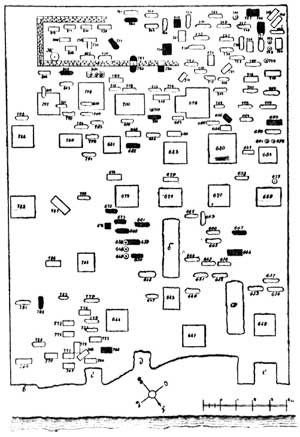 |
| Fig. 560 |
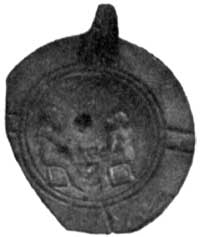 |
| Fig. 561 |
- This catacomb is 4 arch<ines> and 3 versh<oks> l<ong>, 4 arch<ines> w<ide>, and 2 arch<ines> and 3 versh<oks> h<igh>, with the passageway to the e<ast> and two niches in side walls; it was plundered and covered with soil and fine stone. Removed and sieved soil contained: g<old> impression of coin, squeezed from a very rare coin of the Bosporan king Pharsanzes (254-255); child's finger-ring made of wide g<old> plate (the socket is missing its inset stone); single-handled earthen<ware> juglet; 10 plain earthen<ware> lamps; top fragment of earthen<ware> lamp with relief image of two apes sitting on stools and, probably, eating
(fig. 561)
; bron<ze> belt buckle; 2 bron<ze> ring-shaped earrings; pendant in the form of glass amphora; 2 glass shard beads of paste; silv<er> coin of Julia Soaemias (mother of Heliogabalus), and 7 bron<ze> coins, namely: 4 of Theodosius the Great (378-395), 1 Late Roman, and 2 of Chersonesos (Burachkov, <Op. cit.>, pl<ate> XVI, 110 and 112).
- This catacomb is 4 arch<ines> and 6 versh<oks> l<ong>, 3 arch<ines> and 12 versh<oks> w<ide>, and 2 arch<ines> and 8 versh<oks> high, with the passageway to the e<ast> and with 3 niches; it was plundered and filled to the brim with soil and fine stone. The soil removed from it appeared to contain nothing but multitude of human bones and shards of simple earthen<ware> pottery.
In between of these two tombs, there was mound (a) consisting of continuous layer of shards of simple earthen<ware> pottery, mainly of pitchers.
- This collapsed catacomb appeared plundered. The soil removed from it contained nothing but hum<an> bones and earthen<ware> pottery shards.
There was the second mound (б) of simple earthen<ware> pottery shards located higher than the above catacomb, up the slope.
- This collapsed catacomb appeared to contain nothing but bones and broken earthen<ware> pottery.
- -646. Either of these underground tombs contained skeleton of horse. Ir<on> parts of bridles are destroyed by rust.
- Underground tomb. The single skeleton with the head oriented to the n<orth> appeared to be not accompanied by grave goods.
- -649. Two double-handled earthen<ware> urns that contained cremated bones only.
- -651. Two underground tombs, each with one skeleton, which were accompanied by two bron<ze> coins of autonomous Chersonesos, of bad preservation (Burachkov, <Op. cit.>, pl<ate> XV, 68).
 |
| Fig. 562 |
- -655. Four underground tombs, each with one skeleton and no grave goods.
- Underground tomb that contained single-handled earthen<ware> juglet, covered with black slip with brown ornamentation.
- Underground tomb. The single skeleton with the head oriented to the n<orth> appeared not accompanied by grave goods.
- Double-handled earthen<ware> urn. It contained nothing but cremated bones. Below this urn, there was:
- Underground tomb with burial of child, accompanied by dark-slip earthen<ware> bowl.
- Similar tomb that contained narrow-neck handleless earthen<ware> vessel and terracotta statuette of sitting woman, with raised head band in the form of
kokoshnik
(fig. 562)
.
- Similar tomb contained narrow-neck handleless earthen<ware> vessel.
|


